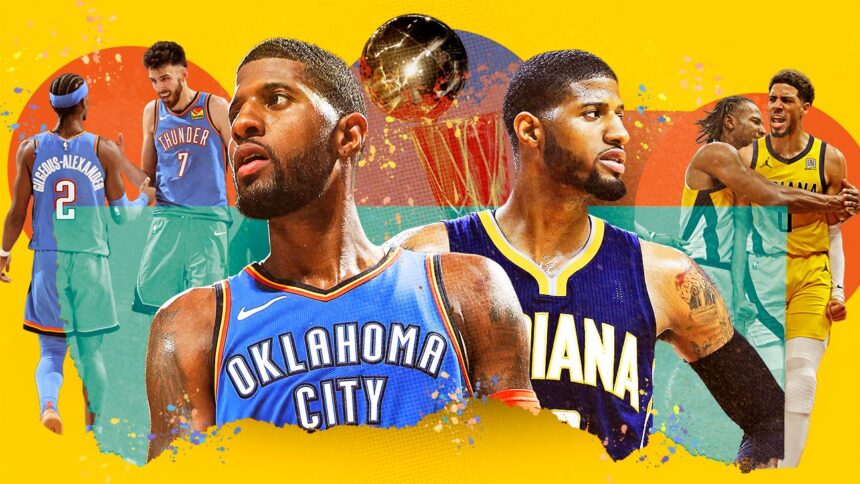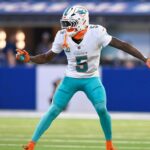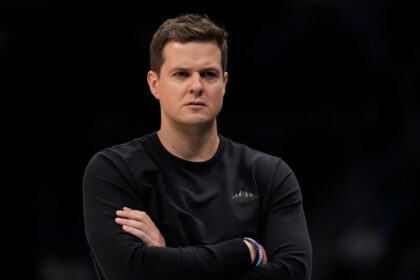The Indiana Pacers and the Oklahoma City Thunder, protagonists of the NBA Finals that begin this Thursday, share a bond forged almost eight years ago: the trade that sent Paul George from the Pacers to the Thunder.
When George, now a nine-time All-Star, requested to join Kawhi Leonard on the LA Clippers in 2019, the Thunder capitalized on the situation to acquire Shai Gilgeous-Alexander, a future MVP, as well as draft picks that have produced All-Stars Jalen Williams and rookie Dillon Jones, with more to come, including the 15th and 24th picks of this year.
After Victor Oladipo and Domantas Sabonis, whom Indiana acquired for George, became All-Stars, the Pacers strategically moved them. Sabonis was the centerpiece of Indiana’s significant deal for Tyrese Haliburton, an All-NBA selection. And the trade of Oladipo for Caris LeVert ultimately gave the Pacers Andrew Nembhard and bench player Ben Sheppard through draft picks acquired from the Cleveland Cavaliers in a deal for LeVert in 2023.Since other NBA teams won’t be able to trade for George in his prime, let’s analyze these deals to see what other teams can learn from how the Pacers and Thunder paved their way to young rosters that reached the Finals.
Oklahoma City Thunder
Transfers:
- Oladipo and Sabonis for George (July 6, 2017)
- George to the Clippers for Gilgeous-Alexander, Danilo Gallinari, five first-round picks and two swaps (July 6, 2019)
Lesson 1: “Scared money doesn’t make any money”
This goes back to the Thunder’s original trade to acquire George from Indiana. Oklahoma City was an unlikely destination for George, who had only one guaranteed year left on his contract in the summer of 2017 before a player option allowed him to become an unrestricted free agent.Many small-market teams, operating cautiously, would have feared George leaving in free agency and never seriously pursued a trade. Thunder executive vice president and general manager Sam Presti, who built Oklahoma City’s first Finals team (2011-12), thought more boldly.
In a “SportsCenter” documentary about George’s free agency, Presti cited a famous lyric from A Tribe Called Quest’s 1993 song “Midnight” as justification for the move: “Scared money don’t make none.”
“If you expect Paul George or any player to have confidence in you as an organization, you have to demonstrate it yourself,” Presti argued.
Although pairing George and Carmelo Anthony with Russell Westbrook didn’t produce the kind of playoff result the Thunder hoped for in 2018 (they lost in a first-round upset to the Utah Jazz), George re-signed with the team that summer. That put Oklahoma City in a prime position when George eventually asked out a year later.
The Thunder may not have viewed the George trade as a huge risk, in part because Oklahoma City didn’t have to give up any picks in the deal. Therefore, the lesson isn’t exactly that teams should recklessly mortgage their future to win now. But being opportunistic can be bold in its own right.
In the short term, this lesson is likely to apply most directly to Kevin Durant’s possible transfer from the Phoenix Suns. A small-market team could take advantage of Durant’s possible free agency in 2026 to get him at a bargain price for his talent.
Description: Shai Gilgeous-Alexander of the Thunder was named NBA MVP in 2025.Lesson 2: Don’t be afraid to use influence
On paper, the Thunder’s return for George was absurd. In later years, the trade of a large number of unprotected first-round picks and swaps has become normalized, but it was unthinkable when George’s trade occurred.
Of course, Oklahoma City knew the Clippers weren’t just getting George. They were also using him to get Leonard, the best free agent on the market and just weeks away from leading the Toronto Raptors to the championship as Finals MVP.
Even so, many NBA decision-makers would have avoided pushing too hard for fear of ruining the deal altogether. And asking for all the picks might have seemed greedy, as the Thunder were also acquiring the promising Gilgeous-Alexander. He wasn’t yet seen as having MVP potential, but he did show All-Star potential as a rookie starter for the Clippers on a playoff team at age 20.
But Oklahoma City was willing to simply keep George and refused to budge on their demands. The Thunder have made smart moves since then and have had some luck. Gilgeous-Alexander proved to be such a blazing star, but it’s everything the Thunder received in the George deal that makes them a potential dynasty.
The Milwaukee Bucks have the best chance of encountering a similar situation if Giannis Antetokounmpo requests a trade. It’s unlikely the Bucks will have much trouble generating strong offers for Antetokounmpo. But they shouldn’t be afraid to wait for the ideal package, particularly if, as with George, they also send Antetokounmpo to a desired destination.Indiana Pacers
Transfers:
- George for Oladipo and Sabonis (July 6, 2017)
- Oladipo for LeVert and two second-round picks (January 16, 2021)
- LeVert and a second-round pick for Ricky Rubio, a first-round pick, and two second-round picks (February 7, 2022)
- Sabonis, Justin Holiday, Jeremy Lamb, and a second-round pick for Haliburton, Buddy Hield, and Tristan Thompson (February 8, 2022)
Lesson 1: Identifying Undervalued Talent
Most of these lessons aren’t based on hindsight. There was growth potential in almost all of these trades at the time. The Pacers’ return for George was a notable exception. Oladipo hadn’t yet reached league average in true shooting percentage through four NBA seasons, while Sabonis had shot worse than 40% as a rookie starter for Oklahoma City. Indiana correctly bet that both players were capable of more.
The Pacers surely saw that Oladipo and Sabonis would benefit from handling the ball more and playing with better spacing for Indiana. Alongside Westbrook with the Thunder, they primarily served in complementary roles that didn’t maximize their abilities. Oladipo’s time of possession nearly doubled from 2.4 minutes per game in his only season with the Thunder to 4.4 with the Pacers, while Sabonis went from shooting 159 three-pointers as a rookie to 121 in total in the following three combined seasons. Oladipo’s breakthrough was more immediate. He went to 23.1 points per game on 48% shooting the following season, while leading the NBA in steals per game, winning the Most Improved Player award and earning All-NBA third team honors. Unfortunately, that was Oladipo’s high point at age 25. The following January, Oladipo suffered a ruptured patellar tendon that altered the trajectory of his career.While Oladipo battled injuries, Sabonis was emerging, first as a runner-up for the Sixth Man of the Year award in 2018-19 and then as an All-Star the following two seasons, as he started alongside Myles Turner on a giant frontcourt. Sabonis is now a three-time All-Star who has finished twice in the top 10 in MVP voting.
Betting on any individual player to follow that trajectory is a fool’s errand, but there are a couple of recent, potentially undervalued first-round picks to take a look at if they enjoyed better situations. San Antonio Spurs forward Jeremy Sochan has struggled to find his place alongside Victor Wembanyama. The Spurs improved after Sochan came out of the lineup last season. If he were playing with a more traditional stretch than Wembanyama, Sochan’s defensive versatility and athleticism might stand out.
Jazz center Walker Kessler is intriguing because his on-court impact in net rating hasn’t matched his impressive rim-protecting numbers. It’s difficult to say how much Utah’s young backcourt influences that. Better defensive execution could highlight Kessler’s strengths and minimize his weaknesses, and better guards could create more opportunities for Kessler to finish the pick-and-roll.
Description: Tyrese Haliburton, on the right, has led the Pacers to their first NBA Finals appearance since the year 2000.Lesson 2: Don’t be afraid to pass through a star
As well as Sabonis developed with the Pacers, there was a limit to his progress. Indiana lost in the first round for three consecutive seasons after George’s trade and was then on its way to a second consecutive lottery appearance as the 2022 trade deadline approached. Another small-market team might have sought to rebuild around Sabonis, a proven star. The Pacers’ willingness to move on is why they are now in the Finals.
Swapping Sabonis for Haliburton as the key members of a six-player trade seemed like a great move at the time. Four years younger, Haliburton was already an established Sacramento starter with All-Star potential on a bargain rookie contract. But the deal left Indiana with a roster heavy on guards and a glaring hole at power forward, a major factor in the Pacers finishing with a 35-47 record the following season, despite Haliburton making his All-Star debut.
Everything came together last season, when Haliburton led Indiana to the inaugural NBA Cup final as an All-NBA selection and the Pacers added Pascal Siakam in a January trade to fill the void at the number 4 position. Indiana reached the Eastern Conference finals in 2024 before losing to the eventual champions, the Boston Celtics. The Pacers have now gone one step further, winning the East for the first time since the year 2000. Although future trips to the Finals are not a certainty, Indiana has its contention window wide open with Haliburton entering his prime at age 25.It’s hard to say which teams could benefit from this lesson. It depends on which established star is desperately sought by a franchise looking to win now and is willing to overpay. The broader takeaway is that, with the exception of the league’s top players, there shouldn’t be an “untouchable” star. As long as your front office can prevent it from leaking and causing damage, it’s always worth taking the call in case the other party is ready to make a mistake.











